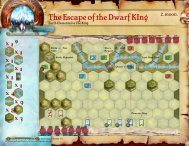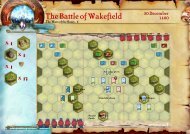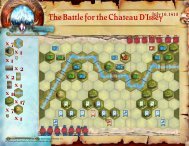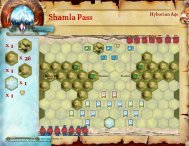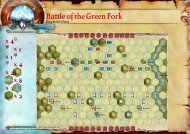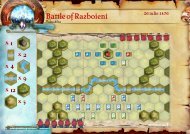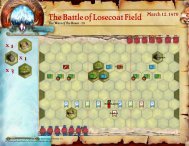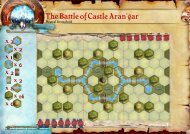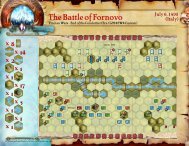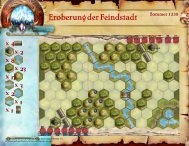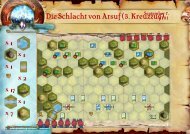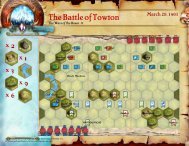The Battle of Mortimer's Cross
The Battle of Mortimer's Cross
The Battle of Mortimer's Cross
Create successful ePaper yourself
Turn your PDF publications into a flip-book with our unique Google optimized e-Paper software.
February 2, 1461<br />
<strong>The</strong> <strong>Battle</strong> <strong>of</strong> <strong>Mortimer's</strong> <strong>Cross</strong><br />
<strong>The</strong> Wars <strong>of</strong> the Roses - 6<br />
x 1<br />
Wiltshire<br />
x 1<br />
x 6<br />
x 2<br />
x 5<br />
x 2<br />
Herbert Edward Wig Marsh<br />
Kingsland River Lugg Cr<strong>of</strong>t Castle<br />
Symbols & Graphics Copyright (c) 2004 - 2007 Days <strong>of</strong> Wonder, Inc.<br />
Produced with permission, for non-commercial use only.
Historical Notes<br />
Only part <strong>of</strong> the Yorkist army was<br />
defeated at Wakefield. Edward Plantagenet<br />
with another Yorkist force, having heard <strong>of</strong><br />
his father's death, moved to intercept a<br />
Lancastrian force under Jasper Tudor,<br />
Earl <strong>of</strong> Pembroke, who was marching into<br />
England from South Wales to join with the<br />
other Lancastrians. Jasper was the son <strong>of</strong><br />
Owen Tudor, Henry VI's stepfather. <strong>The</strong><br />
battle was fought somewhere around<br />
<strong>Mortimer's</strong> <strong>Cross</strong> near Wigmore,<br />
north-west <strong>of</strong> Leominster. Edward deployed<br />
the Yorkist army and engaged the enemy.<br />
<strong>The</strong>y defeated the Lancastrian army,<br />
though we know little <strong>of</strong> the detail <strong>of</strong> the<br />
action, and a number <strong>of</strong> Tudor's<br />
commanders, including Jasper's father<br />
Owen, were captured and later executed in<br />
Hereford. Edward, now calling himself the<br />
Duke <strong>of</strong> York, claimed he had seen three<br />
suns rise in the morning and this had been<br />
an omen <strong>of</strong> victory.<br />
Leadership and Artillery (if artillery is<br />
present) rules can be found on the last<br />
page <strong>of</strong> the Campaign Rules in the files<br />
section<br />
at<br />
http://games.groups.yahoo.com/group/battlelore<br />
calltoarms/<br />
Symbols & Graphics Copyright (c) 2004 - 2007 Days <strong>of</strong> Wonder, Inc.<br />
Produced with permission, for non-commercial use only.<br />
Jasper Tudor<br />
Earl <strong>of</strong> Pembroke<br />
Victory Conditions<br />
X 4<br />
6<br />
WAR COUNCIL Level 0<br />
Conditions <strong>of</strong> Victory<br />
6 banners<br />
Cr<strong>of</strong>t Castle and Kingsland are objectives for the<br />
Lancastrians. Whilst a Lancastrian (Pennant camp) unit<br />
remains on one <strong>of</strong> these hexes it counts as a victory<br />
banner for the Lancastrians.<br />
Special Rules<br />
All Bows except <strong>Cross</strong>bows are Longbows and follow<br />
Longbow rules.<br />
Medieval Lore rules are in effect.<br />
Edward<br />
Plantagenet<br />
Earl <strong>of</strong> March<br />
Victory Conditions<br />
X 5<br />
6<br />
WAR COUNCIL Level 0<br />
Leadership rules apply to the units labelled Wiltshire,<br />
Herbert, and Edward. Use a suitable marker to indicate<br />
units with leaders. Leadership rules are explained in the<br />
historical background.<br />
Cr<strong>of</strong>t Castle plays as a Stronghold, and Kingsland plays<br />
as a basic landmark.<br />
RELUCTANT MERCENARIES (Breton, French, and<br />
Irish)<br />
Each time a Lancastrian unit is eliminated roll 2 dice. On<br />
a roll <strong>of</strong> at least 1 Lore symbol the 4 units marked as<br />
Lancastrian mercenaries leave the battle (are removed<br />
from play). <strong>The</strong>y do not count towards Yorkist victory.



